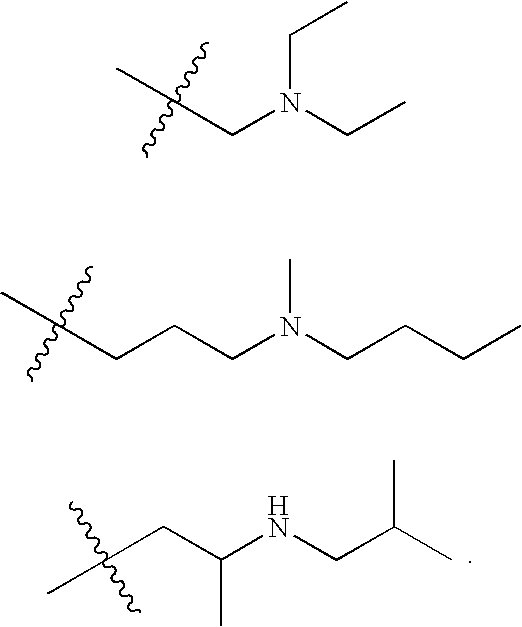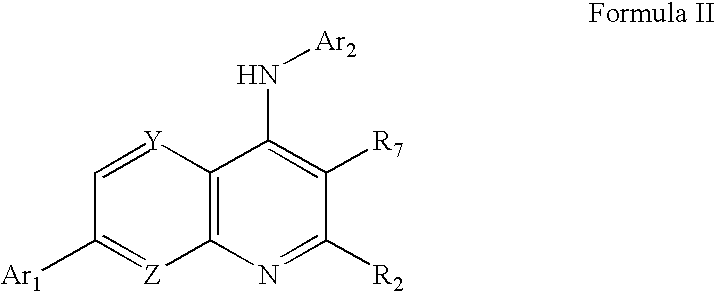Substituted quinolin-4-ylamine analogues
a technology of quinolin-4-ylamine and analogues, which is applied in the field of substitution of quinolin-4-ylamine analogues, can solve the problems of acute or chronic pain, more debilitating, and damage to the nervous system, and achieve the effect of reducing the calcium conductance of a cellular capsaicin receptor and inhibiting the binding of vanilloid ligands
- Summary
- Abstract
- Description
- Claims
- Application Information
AI Technical Summary
Benefits of technology
Problems solved by technology
Method used
Image
Examples
example 1
Preparation of Representative Substituted Quinolin-4-ylamine Analogues
[0281]A. Using the procedure illustrated in Scheme 1, 2-methoxymethyl-7-(3-trifluoromethyl-pyridin-2-yl)-[1,8]napthyridin-4-yl-(4-trifluoromethylphenyl)-amine is prepared by the following steps:
1. 2-cyano-3-trifluoromethylpyridine
[0282]
[0283]DMF (3500 mL), H2O (35 mL), 2-chloro-3-trifluoromethyl-pyridine (250 g; 1.38 mol), Zn(CN)2 (97 g; 0.83 mol), Pd2(dba)3 (19.0 g) and DPPF (22.4 g) are combined in a 22.0 liter flask. The reaction mixture is degassed by bubbling N2 into the reaction mixture over a period of 30 minutes. The reaction mixture is then heated to 120° C. for 4.5 hours, at which time an additional 9.5 g of Pd2(dba)3 and 11.2 g of DPPF is added to the reaction mixture. The reaction mixture is then heated at 120° C. for another 2 hours, and then allowed to cool to room temperature overnight. The resulting dark brown solution is cooled in ice and cold water. A mixture of saturated NH4Cl (1380 mL), 28%NH4O...
example 2
Preparation of Additional Representative Substituted Quinolin-4-Ylamine Analogues
[0352]A. (4-tert-Butyl-phenyl)-[7-(2-trifluoromethyl-phenyl)-quinolin-4-yl]-amine is prepared by the following steps:
1. 7-(2-Trifluoromethyl-phenyl)-quinolin-4-ol
[0353]
[0354]Combine 7-chloroquinolin-4-ol (1000 mg, 5.55 mmol,) 2-(trifluoromethyl)phenylboronic acid (1583 mg, 8.33 mmol) and toluene (50 mL), and bubble nitrogen into the solution for 10 minutes. Add palladium acetate (25 mg, 0.11 mmol), 2-(dicyclohexylphosphino)biphenyl (78 mg, 0.22 mmol), and K3PO4 (2353 mg, 11.1 mmol) and heat at 90° C. for 16 hours. Let cool, add water (25 mL) and EtOAc (50 mL), and remove any insoluble material by filtration. Separate the EtOAc layer, and extract the aqueous layer twice with EtOAc (25 mL each). Combine the EtOAc extracts, dry (Na2SO4), and evaporate. Purify by silica gel chromatography (94% CH2Cl2 / 5% MeOH / 1% NH4OH) to provide 7-(2-trifluoromethyl-phenyl)-quinolin-4-ol as a white solid.
2. 4-Chloro-7-(2-tr...
example 3
Additional Representative Substituted Quinolin-4-ylamine Analogues
[0463]Using routine modifications, the starting materials may be varied and additional steps employed to produce other compounds provided herein. Compounds listed in Table I were prepared using such methods. In the column labeled “IC50” a * indicates that the IC50 determined as described in Example 6 is 1 micromolar or less (i.e., the concentration of such compounds that is required to provide a 50% decrease in the fluorescence response of cells exposed to one IC50 of capsaicin is 1 micromolar or less).
[0464]
TABLE IRet.MSCompoundNameIC50Time(M + 1)12-methyl-N-[4-(trifluoromethyl)phenyl]-7-[3-(trifluoromethyl)pyridin-2-yl]quinolin-4-amine*1.19448.1522-Methoxymethyl-7-(3-trifluoromethyl-pyridin-2-yl)-[1,8]napthyridin-4-yl]-(4-trifluoromethylphenyl)-amine*1.17479.1632-Methoxymethyl-7-(3-trifluoromethyl-pyridin-2-yl)-[1,8]napthyridin-4-yl]-(4-t-butylphenyl)-amine*1.21467.24methyl 2-(methoxymethyl)-4-{[4-(trifluoromethyl)p...
PUM
| Property | Measurement | Unit |
|---|---|---|
| temperatures | aaaaa | aaaaa |
| time | aaaaa | aaaaa |
| flow rate | aaaaa | aaaaa |
Abstract
Description
Claims
Application Information
 Login to View More
Login to View More - R&D
- Intellectual Property
- Life Sciences
- Materials
- Tech Scout
- Unparalleled Data Quality
- Higher Quality Content
- 60% Fewer Hallucinations
Browse by: Latest US Patents, China's latest patents, Technical Efficacy Thesaurus, Application Domain, Technology Topic, Popular Technical Reports.
© 2025 PatSnap. All rights reserved.Legal|Privacy policy|Modern Slavery Act Transparency Statement|Sitemap|About US| Contact US: help@patsnap.com



